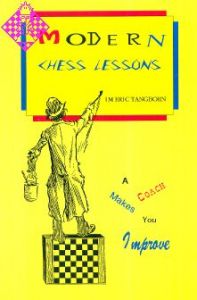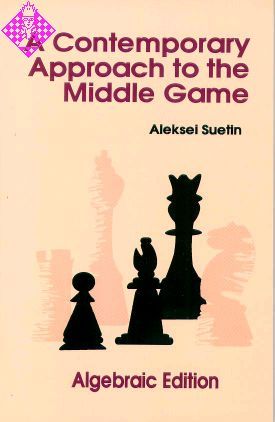Artikelnummer
LMSUEACATTMG
Autor
A contemporary approach to the Middle Game
167 Seiten, kartoniert, Chess Digest, 1992
Final vergriffen
Aleksei Suetin's "Schachlehrbuch für Fortgeschrittene", published by Sportverlag Berlin consisted of three booklets -
Moderne Probleme des Mittelspiels
Moderne Probleme des Positionsspiels
Die Grundlagen der modernen Eröffnung
- published as one volume.
Moderne Probleme des Mittelspiels
Moderne Probleme des Positionsspiels
Die Grundlagen der modernen Eröffnung
- published as one volume.
| EAN | 0875682162 |
|---|---|
| Gewicht | 260 g |
| Hersteller | Chess Digest |
| Breite | 14 cm |
| Höhe | 21,5 cm |
| Medium | Buch |
| Erscheinungsjahr | 1992 |
| Autor | Matthew Sadler |
| Sprache | Englisch |
| ISBN-10 | 0875682162 |
| Seiten | 167 |
| Einband | kartoniert |
| Name | Chess Digest |
|---|
Contents
000 Editor`s Foreword
000 Introduction
001 The Foundations of Strategy
002 - Two Conceptions of Strategy
004 - Particularities of Chess Strategy
009 - The Game Plan
010 - Positional Judgement
014 - Elements of Positional Play
015 - Typical Strategical Developments
020 The Bases of Chess Tactics
020 - Two Ways of Considering Tactics
022 - The Combination
023 - Systematization of Combinational Play
024 - The Most Important Combinational Ideas
032 - Accompanying Combinational Circumstances
038 - Calculation of Combinations and Positional Judgement
040 Linking Strategy and Tactics
040 - Strategy Comes First
045 - Confromity of the Aim with the Means
047 - The Independent Role of Tactics
051 Style
055 - The Two Conceptual Categories of Chess Players
058 - The Measure of Strategic Mastery
061 The Dynamic
061 - A Short Historical Survey
065 - The Essential of Modern Dynamics
066 - The Maximum Proximity of the Plan to the Course of the Game
067 - Conversion of Material into Strength
069 - The Positional Combination
071 - The New Interpretation of the Main Factors, Force, Space and Time
073 - The Impossibility of Going Back on Dynamic Decisions
075 - Systematization of Dynamical Methods
077 - The Difference Between Dynamic and Ordinary Tactical Decisions
077 - Dynamic Struggle in Equal Positions
080 - The Interdependence of Static and Dynamic Treatment
087 The Initiative
087 - The Role of Tempo in the Game
088 - The Initiative, its Unfolding and its Increase
095 - Duration and Stability of the Initiative
105 Transforming Positional Elements
105 - Different Sorts of Transformation
110 - Transformation from Middle Game to Endgame
120 Harmony
120 - Two Kinds of Strategic Principles
121 - The Development of the Principle of Harmony
131 - Importance of the Object of Attack
132 - The Impossibility of Breaking off Dynamic Harmony
133 - Classification of Harmony
137 The Influence of the Dynamic Standpoint
137 - Intuitive Dynamics with Regard to the Masters of the Past
140 - The Art of the Attack on the King
141 - The Creative Extent of True Mastery
143 - From Intuition to Conscious Action
146 - Ultra-Dynamic Style
150 - The Art of Sharpening the Play
152 Relating Middle Games to Opening
152 - The Game as a Unified Course of Struggle
154 - Harmonious Co-ordination in the Opening
158 - The Influence of Development on the Middle Game
158 - Tactical Exploitation of Opening Advantages
160 - Strategic Exploitations of Opening Advantages
166 - Transition to the Middle Game - Positional Balance
000 Editor`s Foreword
000 Introduction
001 The Foundations of Strategy
002 - Two Conceptions of Strategy
004 - Particularities of Chess Strategy
009 - The Game Plan
010 - Positional Judgement
014 - Elements of Positional Play
015 - Typical Strategical Developments
020 The Bases of Chess Tactics
020 - Two Ways of Considering Tactics
022 - The Combination
023 - Systematization of Combinational Play
024 - The Most Important Combinational Ideas
032 - Accompanying Combinational Circumstances
038 - Calculation of Combinations and Positional Judgement
040 Linking Strategy and Tactics
040 - Strategy Comes First
045 - Confromity of the Aim with the Means
047 - The Independent Role of Tactics
051 Style
055 - The Two Conceptual Categories of Chess Players
058 - The Measure of Strategic Mastery
061 The Dynamic
061 - A Short Historical Survey
065 - The Essential of Modern Dynamics
066 - The Maximum Proximity of the Plan to the Course of the Game
067 - Conversion of Material into Strength
069 - The Positional Combination
071 - The New Interpretation of the Main Factors, Force, Space and Time
073 - The Impossibility of Going Back on Dynamic Decisions
075 - Systematization of Dynamical Methods
077 - The Difference Between Dynamic and Ordinary Tactical Decisions
077 - Dynamic Struggle in Equal Positions
080 - The Interdependence of Static and Dynamic Treatment
087 The Initiative
087 - The Role of Tempo in the Game
088 - The Initiative, its Unfolding and its Increase
095 - Duration and Stability of the Initiative
105 Transforming Positional Elements
105 - Different Sorts of Transformation
110 - Transformation from Middle Game to Endgame
120 Harmony
120 - Two Kinds of Strategic Principles
121 - The Development of the Principle of Harmony
131 - Importance of the Object of Attack
132 - The Impossibility of Breaking off Dynamic Harmony
133 - Classification of Harmony
137 The Influence of the Dynamic Standpoint
137 - Intuitive Dynamics with Regard to the Masters of the Past
140 - The Art of the Attack on the King
141 - The Creative Extent of True Mastery
143 - From Intuition to Conscious Action
146 - Ultra-Dynamic Style
150 - The Art of Sharpening the Play
152 Relating Middle Games to Opening
152 - The Game as a Unified Course of Struggle
154 - Harmonious Co-ordination in the Opening
158 - The Influence of Development on the Middle Game
158 - Tactical Exploitation of Opening Advantages
160 - Strategic Exploitations of Opening Advantages
166 - Transition to the Middle Game - Positional Balance
Mehr von Chess Digest
-
 Modern chess lessons17,75 €
Modern chess lessons17,75 €

